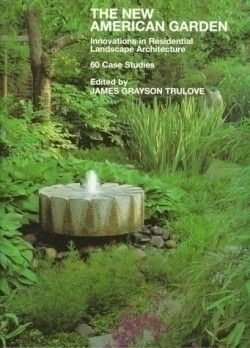It looks like you've stumbled upon a page meant to be read by our code instead of viewed directly. You're probably looking for this page.
The New American Garden
Innovations in Residential Landscape Architecture: 60 Case Studies
Look around at the suburban garden of today and what you will notice is an overt lack of the “human touch.” The typical American yard isn’t a garden at all; it’s a thoughtless collection of shrubs, a few tulips, and a chem-lawn. The 60 case studies offered in this volume, like the residences they surround and enhance, aren’t tinkered with by their inhabitants either. These homes and gardens are the dream stuff of ambitious gardeners. Nevertheless, on the whole they do attempt to exercise the concepts of The New American Garden as put forward by James van Sweden and Wolfgang Oehme: mass plantings of self-sustaining plants for four seasons of bloom, the elimination of large lawns, and the use of “borrowed scenery.”
While this is not necessarily a book for the garden-variety gardener, it should be a book for new homebuilders and major remodelers. In most of these cases, the landscape architect was chosen at the same time as the dwelling architect for initial construction or reconstruction, and the designs seek to visually unite the construction with the natural environment. The photographs are stunning and the design and program notes are interesting and thought-provoking. These are plans that seek to create harmony within and without and are a far cry from a trip to the market nursery for a flat of petunias. Although most of the studies are designed to integrate with the home and surrounding landscape, there are also a couple of purely whimsical models, as well as rigidly formal ones. Climate conditions range over most of the United States from desert to jungle to Midwest and Northeastern suburbia. Each case includes a short section on how the garden was made and under what conditions, site plans, lists of major plants and materials, climate and soil conditions, and often, plant care and irrigation needs. There are disconcerting editing errors in USDA Agricultural Zone numbers. Southern California, for example, is sometimes a “2” and sometimes a “22.” Neither one of these is anywhere near the truth and it raises questions of accuracy: Is San Juan Island really only a Zone 5? Finally, there is a comprehensive index of plants, materials, and construction and architectural groups.
The New American Garden is an inspiring book for garden designers, architects, and landscape architects, but the photographs of low-maintenance mass-plantings should win the hearts of the American suburban dweller. Although these homes and gardens are top-of-the line, the concepts illustrated in this book are not any more costly than a chem-lawn, a lawnmower, and all the weekends in a summer. Working with a local landscape nursery and the lists of self-sustaining plants, homeowners everywhere could make their yards viable not only for the environment, but also for their weekend leisure.
Reviewed by
H. Shaw Cauchy
Disclosure: This article is not an endorsement, but a review. The publisher of this book provided free copies of the book to have their book reviewed by a professional reviewer. No fee was paid by the publisher for this review. Foreword Reviews only recommends books that we love. Foreword Magazine, Inc. is disclosing this in accordance with the Federal Trade Commission’s 16 CFR, Part 255.
